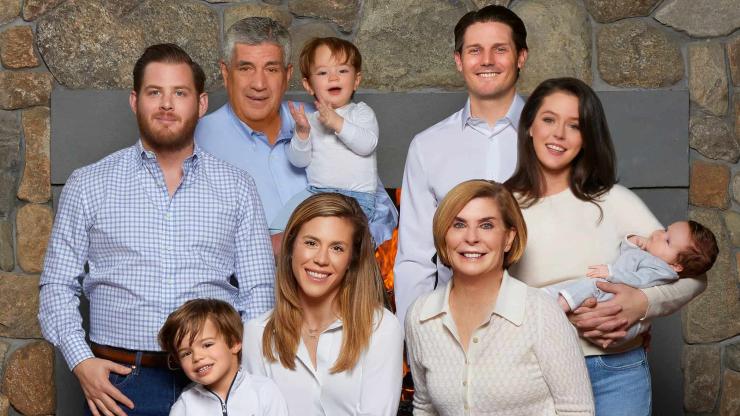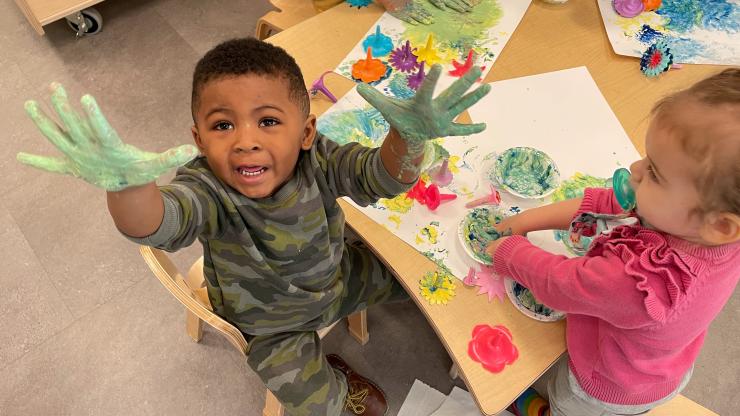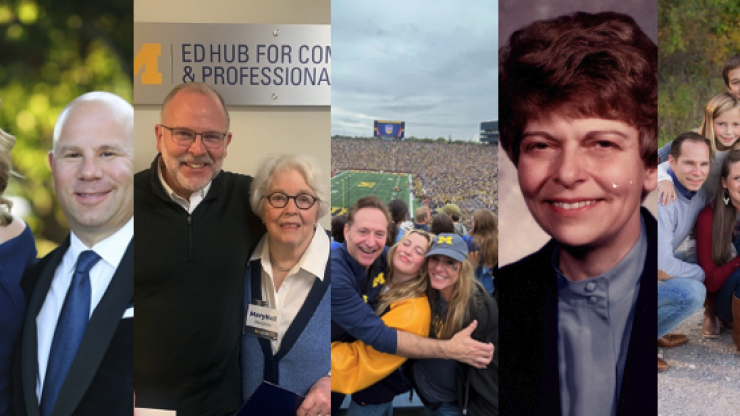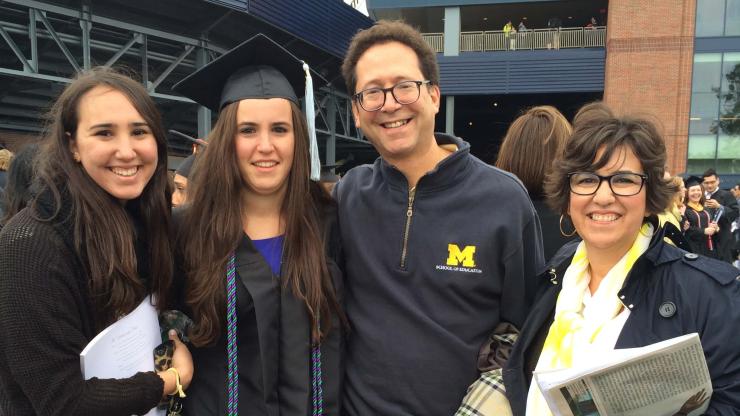The Michigan Education Teaching School
An innovative approach to teacher education delivers on its promise.
In the fall of 2019, when the School at Marygrove (TSM) opened the doors to its first class of ninth graders, the Michigan Education Teaching School launched alongside it—with three interns, one resident, and plenty of big ideas for long-term growth.
TSM is in the Detroit Public Schools Community District (DPSCD), located in northwest Detroit, and the site of the nation’s first Teaching School. The Teaching School, with its similarities to the medical education model of teaching hospitals, is designed to improve the retention of early career teachers by providing additional training and support in their first years in the classroom. The model also honors the complexity of the teaching profession, drawing on the wisdom of experienced educators and the benefits of the collaborative exploration of teaching practice.
“There are a lot of teachers who quit during their first year, or right after their first year, because it’s so hard,” says P-20 Curriculum and Teacher Education Coordinator Dr. Alistair Bomphray (AB ’00, PhD ’18). By building a mutually supportive, intergenerational community of educators, the Teaching School aims to change that trend.
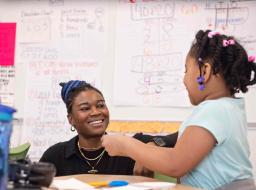
In the Teaching School, students who are completing their degree programs and simultaneous classroom training are known as interns. They are overseen by attending teachers—professional educators in whose classrooms they practice teaching. Once interns graduate with their degrees and teaching certification from the Marsal School, they have preferred hiring status to apply for open positions at TSM, wherein they become teaching residents. Residents are state of Michigan standard certified, full-time paid employees of DPSCD who benefit from an additional three years of onsite mentorship and support provided by attending teachers and U-M faculty and staff.
Four years into piloting this innovative teacher education model, there are many milestones to celebrate. Sneha Rathi (BS ’19, TeachCert ’19), the first teacher to complete the residency, is now Chief of Residents and serves as a mentor to seven current residents who are following in her footsteps. As the elementary school welcomed its inaugural classes of kindergarten, first, and second graders, the first elementary interns, student teacher, and four residents came on board. And the Teaching School continues to grow to serve interns in new ways, such as through a new model for embedded teacher education.
With an eye toward ensuring a strong classroom experience for future interns and residents, Bomphray says DPSCD and U-M work together to intentionally hire attending teachers who want to be part of the intergenerational community of educators.
“We are looking for folks who want to mentor new teachers,” says Bomphray. “We have faculty who came here knowing that the job is to bring new teachers into the profession.”
When Michael Chrzan (BS ’16) interviewed with TSM to become its founding math teacher, the Teaching School was a major draw. Beyond teaching the 30 students in his classroom, Chrzan knew that the impact he could make by training future teachers was exponential. Already, he’d set a personal goal to have a student teacher in his classroom by the time he was in his fifth year teaching. He joined TSM in his fourth year, and had an intern that first semester. This past fall, he had six.

“The idea of having a hand in developing the next generation of teachers was really important for me,” says Chrzan. “I think that of all the content areas math is the one that is most misunderstood in the K-12 environment. Many people who go into teaching have a tendency to want to recreate teaching that was good for them, but might not necessarily be good teaching. For me, a big part of coming to Marygrove was wanting to help create really fantastic math teachers.”
The math interns rotate through different math courses at TSM, but practice teaching in Chrzan's classroom, under his supervision. He also serves as their field instructor, an innovation on the typical practice of field instructors coming from the university and traveling to multiple school sites to observe their interns. One of many benefits inherent in embedded field instruction is that Chrzan understands the school context in which the interns are learning and teaching. It is also training for those who know they would like to teach full time in an urban setting.
As an attending teacher, Chrzan is passionate about modeling the benefits of project-based learning and restorative justice practices for his interns. Math teachers, he tells his interns, always have to be prepared for a student to ask “When are we ever going to use this?” “In a project-based learning environment,” he says, “you never get that question.”
Bomphray’s goal is to foster a community of teachers and mentors that works together to support interns and residents as well as serve students. He has built close relationships with the school’s attending teachers, making sure to have personal touchpoints with them multiple times each semester. He and his team also lead a quarterly seminar for attending teachers to develop their practice as mentors and discuss challenges that come up along the way with their interns and residents. The hope is that interns who do their student teaching at TSM will be inspired to apply for the three-year residency.
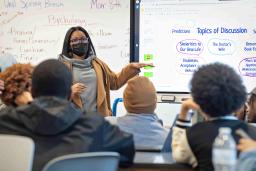
When it came to choosing her field placement, Faith Crosby (ABEd ’22, TeachCert ’22) says she specifically wanted to observe Black teachers. Crosby, who is a Detroit native and who hails from a lineage of teachers, was placed in Lisa Brooks’s 11th grade English class at TSM.
“She did a great job of getting me into the groove of taking over full-time classes. I got great advice, ideas, guidance, and just a great model of another Black female teacher,” says Crosby. When Crosby’s internship was complete, and she was ready to look for jobs, Brooks encouraged her to look at all her options. The commitment to the three-year residency inherent in a position at TSM was daunting, but ultimately, she decided to go for it.
“I loved and connected with the kids. And I really appreciated the bonds that I had made here. I just wanted to continue them. I felt like that was a good foundation to start my teaching career on. I was working with 11th graders last year, and they’re my 12th grade students now. That’s just a great leg up for being a first-year teacher. Instead of having to go through building relationships, I could already start with that. It made my flow into being a professional teacher much easier.” Not only are her students familiar, so are the other teachers in the school. Brooks is now a colleague. If Crosby has a question, or is seeking advice, Brooks is close at hand, together with multiple TSM team members, including Bomphray, all of whom are experienced teachers and experts in education.
As a first-year resident in the Teaching School, Crosby is supported by Bomphray, who serves as her U-M staff mentor.
“He visits one of my English classes at least once a week to see what’s going on, but also to be a support. If I need help in the classroom, he’s there. Alistair can give me immediate feedback on what he’s observing.” Because he visits regularly, says Crosby, he’s able to see both her and her students’ development week over week. When it’s helpful, Bomphray comes up with additional teaching materials that might support the student’s learning goals—for example, poems and readings related to the coursework. Crosby also teaches a psychology class. Although Bomphray’s area of expertise is English, he introduced her to colleagues who could lend support in that subject if she needed it.
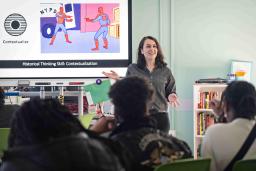
Lindsay Helfman (AB ’06, AM ’21, TeachCert ’21), a second-year resident who teaches 12th grade world history, says the residency position at TSM was the only job she applied for after completing her student teaching there.
“I had a fantastic attending teacher, and she’s why I applied for the job. Her name is Jane Jordan. She’s the ninth grade U.S. history teacher. She was everything that I wanted to be as a teacher, so I knew I wanted to be here, too.”
Helfman’s residency mentor is Dr. Darin Stockdill (AB ’91, PhD ’11), Instructional and Program Design Coordinator for the Center for Education Design, Evaluation, and Research at the Marsal School, and a former social studies teacher. The two describe each other as thought partners.
“A lot of the work I do with Lindsay is helping to develop the teaching materials that she’s going to use and then helping her think through how things went in class,” says Stockdill of his mentorship role. “It’s collegial, just another brain in the room to help think through everyday problems of practice.”
Last year, the pair worked together to build a world history curriculum.
Helfman says, “We wanted to come up with something that was project-based and relevant to the lives of our students.” In their first year working together, Stockdill helped her plan lessons and get the curriculum off the ground. In year two, they are refining it. Now they can look at data from students to see where they need to build in additional lessons to target students’ progress and skill sets. A goal this year was wanting to improve student reading practices. Together, they are working on literacy development in the context of social studies instruction.
“It’s very, very difficult to teach and you constantly feel like a failure, but Darin is a practical person. His whole outlook is always, ‘Let’s find a way forward.’ Having someone like that is just invaluable,” says Helfman. “That support should be provided for teachers everywhere.”
“This model enables us to build longitudinal relationships, which is pretty unique,” says Stockdill. “I certainly wish I had experienced it when I went through my teacher education program. To have somebody to talk to and think about pedagogical issues within those first couple years is so important. A lot of what I do is say, ‘What you did was fantastic, do it again.’ Just having that validation is helpful.”
Above all, Crosby and Helfman agree that being part of a cohort of new teachers is their most valued aspect of the residency. This year, the Teaching School was home to four residents in the high school.
“The most useful thing is getting to meet and work with other early career teachers that are in the same residency program,” says Helfman. “You have people that you vent with and talk to, but also they understand and care more about the problems in your classroom because they affect the problems in their classroom, and we all care about the same group of students.”
“Having the other U-M residents here at TSM has been very special,” says Crosby. “We all go through the same problems and we all have the same questions, so it’s nice to be able to lean on people that are in the same space with the same students or had the same students in the past. They also know the structure of the school, and know what’s going on when I might not. That’s probably the biggest thing that I appreciate about the residency—the community.”
Sneha Rathi, who started as the Teaching School’s first resident in 2019, has now completed her residency. This fall she was promoted to Chief of Residents, a role funded by the Marsal School, which will be filled by alternating resident faculty as more teachers engage in the residency. Rathi convenes a monthly meeting for current residents—a dedicated space where, in the company of fellow new teachers, they can let down their guard, and talk openly with each other about how the school year is going.
“What are the yeas and nays?” Rathi asked residents as they gathered around a box of doughnut holes at a recent meeting. On the whiteboard, Rathi had posed two questions to focus the afternoon’s discussion: “How has your organization been?” and “How do we build strong, healthy relationships with students?”
Residents joked with each other about the day’s events. They debated whether the afternoon tornado drill had been for a tornado watch or a tornado warning—each has its own protocol. The group discussed the difference. As they got comfortable, and settled into the space, Rathi led them deeper into discussion.
“What’s going on? What are the fires?” One resident was in the midst of navigating the process of having a student transfer out of their class. “What support do you need for that?” asked Rathi.
